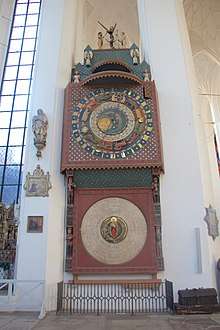Gdańsk astronomical clock
The Gdańsk astronomical clock is a fifteenth-century astronomical clock in St. Mary's Church, Gdańsk.

Gdańsk Astronomical Clock
History and description
The clock was constructed between 1464–1470 by Hans Düringer.[1][2] Its complex dials show the time and date, phases of the moon, the position of the moon and sun in relation to the zodiac signs, and the calendar of saints. Adam and Eve ring the bell on the hour, and at noon a procession appears that features Adam and Eve alongside the Three Kings, the Apostles, and Death.[3]
Standing 14 metres (46 ft) high, upon completion the clock was the largest in the world,[4] and it may remain the largest wooden astronomical clock.
Due to severe damage in World War II, it was reconstructed after 1945.
gollark: <@478798120650670091> Why would I DO that? WHY?
gollark: Using a single CC file would probably create problems with, er, atomicity or whatever.
gollark: Interesting idea but dealing with file handles would be irritating. I could just steal the code from Opus I guess and stick a note in the licenses.
gollark: I mean, sort of.
gollark: You can still *edit* it.
References
| Wikimedia Commons has media related to Astronomical clock in the St. Mary's Church in Gdańsk. |
- Bujak, Adam (2007). Polish Cathedrals. ISBN 9788360292372.
- The Newcomen Bulletin. Issues 158-169. p 14. Newcomen Society (Great Britain) 1994
- DK Eyewitness Guide: Eastern and Central Europe. Dorling Kindersley Ltd. 2012. p. 211. ISBN 9781405393515.
- Bousfield, Jonathan; Salter, Mark (2009). The Rough Guide to Poland.
This article is issued from Wikipedia. The text is licensed under Creative Commons - Attribution - Sharealike. Additional terms may apply for the media files.